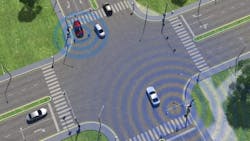Testifying before the House Committee on Science, Space and Technology’s Subcommittee on Research and Technology on Capitol Hill this week, Kristen Tabar – one of Toyota’s vice presidents based at the OEM’s technical center in Ann Arbor, MI – stressed that lawmakers should preserve and protect the short- to medium-range wireless spectrum necessary for V2V and V2I to function properly as it is being threatened by interference from unlicensed devices.
"For the auto industry and those who have been involved in the development of this technology, the use of the spectrum allocated for V2V and V2I communication by unlicensed devices raises significant, and possibly insurmountable, concerns about the potential for harmful interference" Tabar said.
“It would also be unfortunate if the U.S. had to shut the door on V2I communication technology because of a lack of intelligent infrastructure investment,” she added. “Congress and U.S. Department of Transportation (DOT) should be looking at ways to incentivize or facilitate the build out of infrastructure to support V2I communication.”
[Though it’s very dry, the nine-minute DOT presentation DOT below provides a good overview of the V2V and V2I concepts.]
Tabar also stressed that automobile itself currently undergoing a “technological transformation” not only designed to reduce crash risk, boost safety, and improve fuel efficiency, but bring greater convenience and improved quality of life to drivers and passengers alike – a transformation driven in large part by an increasing level of connectivity in all vehicles.
Toyota’s Fun Vii concept car provides a good example of what all those “transformative” efforts may lead to in terms of reshaping vehicle form and function.
Such “transformation” through connected vehicle technology and other design enhancements isn’t going to be limited to cars and light trucks either. Take Wal-Mart’s concept tractor-trailer, for instance, which offers some radical design departures – inside and out – from traditional big configurations in an effort to boost commercial vehicle efficiency.
V2V and V2I communication technology is also being viewed as a crucial support mechanism for what Toyota’s Tabar called “automated driving,” which is a futuristic transport concept that’s become reality in a variety of field tests around the world – again, including commercial vehicles.
Yet the challenges where connected vehicle technology is concerned isn’t just limited to obtaining and keeping the necessary wireless communication spectrum to make them work – there are security and privacy concerns, too, noted Tabar in her testimony.
“The truth is that the success of the technology is in large part dependent on public acceptance, and public acceptance requires that the network be adequately secure and that the privacy of drivers and passengers be preserved,” she said.
[Toyota’s rival Honda is also making efforts to address such concerns in its connected vehicle project.]
That’s one reason why Toyota does not anticipate full integration of the communication system and electronic control elements of the vehicle anytime soon, largely to limit ramifications of a potential “cyber incident,” Tabar pointed out.
“As systems become more integrated, security will become an undeniably critical element,” she stressed. “The good news is that the connected vehicle system is being developed to support the security that is required and to minimize the potential for hacking. But it would also be tragic if uninformed and exaggerated concerns about security and privacy ended up chilling the further development of this transformational technology that will save lives.”




